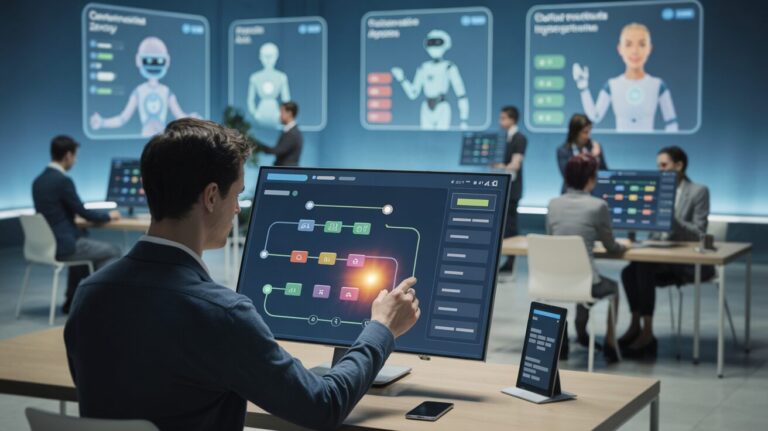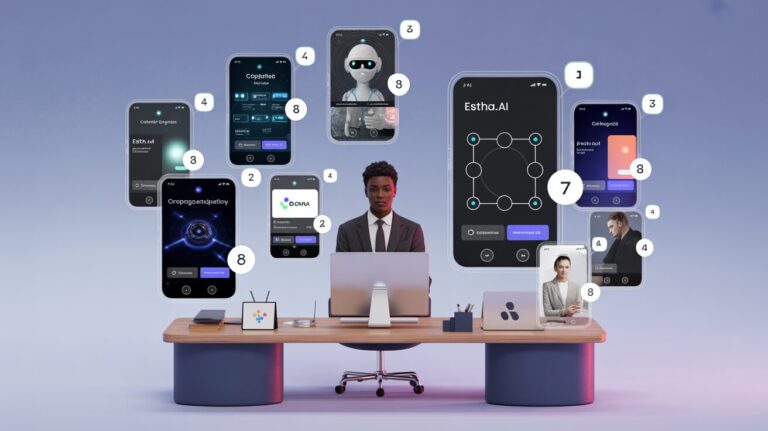Table Of Contents
- Understanding Telehealth Triage Assistants with Voice AI
- Key Benefits of Voice AI in Telehealth Triage
- Challenges in Implementing Voice AI Triage Solutions
- Building Custom Telehealth Triage Assistants Without Coding
- Real-World Applications of Voice AI Triage Systems
- The Future of Telehealth Triage with Voice AI
- Getting Started with Your Own Voice AI Triage Assistant
The healthcare landscape is rapidly evolving, with telehealth emerging as a cornerstone of modern patient care. At the forefront of this transformation are telehealth triage assistants powered by voice AI technology – sophisticated systems designed to assess patient symptoms, determine care urgency, and direct patients to appropriate resources, all through natural voice interaction.
As healthcare providers face increasing patient volumes and resource constraints, these AI-driven triage systems are becoming essential tools for efficiency and accessibility. They serve as the critical first point of contact, capable of gathering preliminary information, assessing symptoms, and determining next steps – all before a human provider enters the conversation.
The integration of voice technology with medical triage represents a significant leap forward. Unlike traditional chatbots that require typing, voice AI triage assistants create a more intuitive, accessible experience that mimics natural conversation while capturing vital health information. This is particularly valuable for patients with mobility issues, visual impairments, or those who simply prefer speaking to typing.
In this comprehensive guide, we’ll explore how telehealth triage assistants with voice AI are revolutionizing healthcare delivery, the tangible benefits they offer to both providers and patients, and how healthcare professionals can now create customized triage solutions without any coding knowledge using innovative no-code AI platforms.
Telehealth Triage Assistants with Voice AI
Transforming Healthcare Delivery
What Are They?
Voice AI triage assistants combine speech recognition, natural language processing, and clinical decision support systems to assess patients’ symptoms through natural conversation and direct them to appropriate care.
How They Work
Patients speak naturally about their symptoms, while AI understands context, asks relevant follow-up questions, applies clinical algorithms to assess urgency, and recommends appropriate next steps.
Key Benefits
Enhanced Accessibility
Makes healthcare more accessible to elderly patients, those with disabilities, and anyone who prefers speaking to typing
Optimized Resources
Reduces administrative burden, directs patients to appropriate care levels, and identifies high-risk cases requiring immediate attention
Consistent Quality
Delivers standardized assessment for every patient, following consistent protocols regardless of time or day
Real-World Applications
Primary Care
Handles intake for common complaints and identifies which cases need same-day appointments versus routine scheduling
Emergency Medicine
Prioritizes cases based on clinical urgency and enables more efficient resource allocation
Specialty Care
Tailored systems for mental health, pediatrics, and chronic disease management with specialized assessment criteria
No-Code Revolution
Healthcare providers can now create custom voice AI triage solutions without any coding knowledge
Voice AI triage assistants represent one of the most promising applications of artificial intelligence in healthcare, making care more accessible, efficient, and patient-centered.
Understanding Telehealth Triage Assistants with Voice AI
Telehealth triage assistants powered by voice AI represent the intersection of advanced speech recognition technology, natural language processing, and clinical decision support systems. These intelligent tools are designed to serve as the first point of contact for patients seeking remote healthcare services.
At their core, these systems utilize voice recognition technology to interact with patients naturally through spoken language. The patient simply speaks their symptoms and concerns, and the AI processes this information in real-time. What makes these systems truly remarkable is their ability to go beyond basic transcription – they can understand context, ask relevant follow-up questions, and apply clinical algorithms to assess symptom severity.
Key Components of Voice AI Triage Systems
An effective telehealth triage assistant with voice AI typically incorporates several sophisticated technologies:
Speech Recognition: The foundation of any voice AI system is its ability to accurately convert spoken language into text. Modern speech recognition systems can understand diverse accents, dialects, and even function effectively in noisy environments.
Natural Language Processing (NLP): Beyond simple transcription, NLP allows the system to comprehend the meaning behind a patient’s words, identifying symptoms, conditions, and concerns from natural conversation.
Clinical Decision Support: The core intelligence of triage systems lies in their ability to apply medical knowledge and decision trees to assess symptom severity and recommend appropriate actions.
Conversational AI: These systems maintain coherent, contextual conversations, asking relevant follow-up questions and providing appropriate responses based on previous interactions.
What distinguishes modern voice AI triage assistants is their ability to conduct conversations that feel natural and empathetic. Rather than rigid, robotic exchanges, these systems can adapt their questioning flow based on patient responses, prioritize critical symptoms, and even detect emotional cues in a patient’s voice that might indicate distress or anxiety.
Key Benefits of Voice AI in Telehealth Triage
The integration of voice AI into telehealth triage systems offers transformative benefits for healthcare providers, systems, and most importantly, patients. These advantages extend beyond simple convenience to create meaningful improvements in care delivery and outcomes.
Enhanced Accessibility and Patient Experience
Voice interaction removes significant barriers to healthcare access. For elderly patients, those with limited technical proficiency, individuals with physical disabilities, or patients with low literacy, voice-based systems offer a more natural and less intimidating way to engage with healthcare services. The intuitive nature of speaking, rather than navigating complex menus or typing symptoms, creates a more inclusive telehealth experience.
Moreover, voice AI triage can capture nuances in a patient’s tone and speech patterns that might be missed in text-based interactions. These subtle cues can provide valuable additional context about a patient’s condition and emotional state.
Optimized Resource Allocation
For healthcare systems struggling with staffing shortages and increasing demand, voice AI triage tools offer a powerful solution for resource optimization. By handling initial patient intake and preliminary assessment, these systems can:
• Reduce the administrative burden on clinical staff, allowing them to focus on direct patient care
• Accurately direct patients to the appropriate level of care, preventing unnecessary emergency department visits
• Identify high-risk cases that require immediate attention
• Gather comprehensive preliminary information before a provider consultation, making subsequent interactions more efficient
Consistent Quality and Standardization
Unlike human triage, which can vary based on the individual provider’s experience, fatigue level, or biases, AI-driven triage follows consistent protocols for every patient interaction. This standardization ensures that all patients receive the same high-quality initial assessment regardless of when they access the system.
Voice AI triage systems also excel at documentation, automatically creating detailed records of patient interactions that integrate seamlessly with electronic health records. This comprehensive documentation improves care continuity and reduces the risk of important information being overlooked.
Challenges in Implementing Voice AI Triage Solutions
While the potential benefits of voice AI triage assistants are substantial, healthcare organizations must navigate several challenges when implementing these solutions.
Clinical Accuracy and Safety
The primary concern with any healthcare AI system is ensuring clinical accuracy and patient safety. Voice AI triage systems must be developed with rigorous clinical validation and extensive testing across diverse patient populations. They must be able to recognize serious symptoms that require immediate medical attention and err on the side of caution when uncertain.
Healthcare providers must also carefully define the scope and limitations of AI triage systems, ensuring they’re used appropriately and that pathways exist for immediate human escalation when necessary.
Technical and Integration Barriers
Traditionally, implementing sophisticated voice AI systems required significant technical expertise, substantial development resources, and specialized knowledge in both healthcare and artificial intelligence. Many healthcare organizations, particularly smaller practices and clinics, lack the technical infrastructure and expertise to develop or customize these solutions to their specific needs.
Integration with existing electronic health records and telehealth platforms presents another challenge. Without seamless integration, the efficiency benefits of AI triage can be diminished by duplicate data entry and workflow disruptions.
Privacy, Security, and Compliance
Healthcare applications must meet stringent requirements for patient data protection and regulatory compliance. Voice AI systems that process sensitive health information must implement robust security measures and comply with healthcare privacy regulations such as HIPAA in the United States and similar frameworks globally.
The collection and storage of voice data introduces additional privacy considerations beyond those associated with text-based systems. Healthcare organizations must ensure that voice data is appropriately secured, with clear policies around data retention and use.
Building Custom Telehealth Triage Assistants Without Coding
The emergence of no-code AI platforms is democratizing access to sophisticated voice AI technology for healthcare providers of all sizes. These platforms enable healthcare professionals to create customized triage solutions that reflect their specific clinical workflows, patient populations, and practice specialties – without requiring technical expertise.
The No-Code Revolution in Healthcare AI
Platforms like Estha are transforming how healthcare providers approach telehealth triage by removing the technical barriers to creating custom AI applications. With an intuitive drag-drop-link interface, healthcare professionals can design voice-enabled triage systems that incorporate their clinical expertise and practice-specific protocols.
This represents a paradigm shift from the traditional model of healthcare technology development, where clinical experts would need to translate their requirements to technical teams. Instead, the healthcare providers themselves become the creators, ensuring the technology precisely matches their clinical needs.
Key Features of No-Code Voice AI Triage Solutions
Modern no-code platforms enable healthcare providers to implement sophisticated triage capabilities including:
Customized Clinical Decision Trees: Providers can build triage logic that reflects evidence-based guidelines and specialty-specific knowledge, ensuring patients receive appropriate guidance based on their symptoms.
Natural Conversation Flows: No-code platforms allow for the creation of natural, dynamic conversation patterns that adapt based on patient responses, rather than following rigid scripts.
Multi-modal Interactions: While voice is the primary interface, comprehensive triage solutions often incorporate other modes of communication, such as text chat or visual elements for symptom selection or education.
Integration Capabilities: Leading no-code platforms offer the ability to connect triage solutions with existing healthcare systems, including appointment scheduling, EHR systems, and telehealth platforms.
Real-World Applications of Voice AI Triage Systems
Voice AI triage assistants are finding successful applications across diverse healthcare settings, demonstrating their versatility and value in improving care delivery.
Primary Care and General Practice
In primary care settings, voice AI triage assistants serve as efficient front-line tools that help practices manage high patient volumes. These systems can handle initial intake for common complaints, identify cases that require same-day appointments versus those that can be scheduled routinely, and even manage routine follow-ups for chronic conditions.
Primary care providers have found that voice-based triage helps identify patients who might otherwise delay seeking care due to uncertainty about symptom severity. The conversational interface makes it easier for patients to describe vague or complex symptoms that they might struggle to categorize in a form or menu-based system.
Emergency Medicine and Urgent Care
In emergency and urgent care settings, voice AI triage systems help prioritize cases based on clinical urgency. By conducting initial assessments before patients arrive at a facility, these systems enable more efficient resource allocation and reduced wait times for serious conditions.
Some healthcare systems are implementing voice AI triage as part of their emergency call centers, helping to identify life-threatening situations that require immediate dispatch of emergency services versus conditions that can be managed through telehealth or in-person visits.
Specialty Care Applications
Specialty practices are adopting voice AI triage systems tailored to their specific domains. For example:
Mental Health: Voice-based screening tools can assess symptoms of depression, anxiety, and other mental health conditions, helping providers prioritize cases and direct patients to appropriate resources.
Pediatrics: Specialized pediatric triage systems incorporate age-specific assessment criteria and can assist parents in determining when children need immediate medical attention versus home care.
Chronic Disease Management: For conditions like diabetes, heart failure, or COPD, voice AI triage can monitor symptoms between appointments and alert providers to concerning changes that might indicate deterioration.
The Future of Telehealth Triage with Voice AI
The evolution of telehealth triage with voice AI is just beginning, with several emerging trends likely to shape its future development.
Multimodal AI Integration
The next generation of telehealth triage systems will integrate voice AI with other AI capabilities, including image analysis and remote monitoring. Patients might describe symptoms verbally while simultaneously sharing photos of visible symptoms or data from connected health devices, creating a more comprehensive assessment process.
These multimodal systems will create richer interactions, combining the natural interface of voice with visual and data-driven elements that enhance diagnostic accuracy and patient experience.
Ambient Intelligence in Healthcare
As voice AI technology advances, we’re moving toward ambient intelligence systems that can participate in and enhance natural healthcare conversations. Future triage systems may be able to listen to conversations between patients and providers, automatically documenting important clinical information and suggesting relevant questions or considerations based on the discussion.
This ambient capability will make voice AI an invisible but invaluable assistant in the telehealth process, reducing documentation burden while ensuring comprehensive assessments.
Personalized Risk Assessment
Advanced voice AI triage will increasingly incorporate personalized risk factors, including patient history, demographics, and social determinants of health. By considering these individual factors, triage systems will provide more accurate assessments of symptom severity and appropriate next steps.
This personalization will help address healthcare disparities by ensuring that risk assessments account for factors that may disproportionately impact certain populations, leading to more equitable care recommendations.
Getting Started with Your Own Voice AI Triage Assistant
For healthcare providers interested in implementing voice AI triage solutions, the process has become remarkably accessible thanks to no-code platforms. Here’s a practical approach to getting started:
Define Your Clinical Requirements
Begin by clearly defining the clinical scope and objectives for your triage system. Consider:
• What types of conditions and symptoms will your triage system address?
• What are the potential care pathways and outcomes?
• What clinical guidelines and decision criteria will you incorporate?
• How will the system escalate urgent cases to human providers?
The more clearly defined your clinical parameters, the more effective your voice AI triage system will be in delivering appropriate guidance to patients.
Choose the Right Platform
When selecting a no-code AI platform for building your telehealth triage assistant, consider these key factors:
Healthcare Expertise: Look for platforms with specific healthcare capabilities and understanding of medical terminology and concepts.
Voice Quality and Accuracy: Evaluate the quality of the voice recognition and natural language understanding, particularly for medical terminology.
Customization Options: Ensure the platform allows you to build decision trees that reflect your specific clinical workflows and protocols.
Integration Capabilities: Consider how the triage assistant will connect with your existing systems, including EHR, patient portal, and telehealth platforms.
Compliance and Security: Verify that the platform meets healthcare data protection requirements and has appropriate security certifications.
Estha’s no-code AI platform is specifically designed to meet these requirements, allowing healthcare providers to create sophisticated voice AI applications without technical expertise. The platform’s intuitive drag-drop-link interface makes it possible to build custom triage solutions in minutes rather than months.
Implement, Test, and Refine
Once you’ve built your voice AI triage assistant, follow these best practices for implementation:
Start Small: Begin with a limited scope, perhaps focusing on a specific condition or common symptoms, before expanding to more complex triage scenarios.
Test Thoroughly: Conduct extensive testing with diverse scenarios and patient profiles to ensure the system responds appropriately to various inputs.
Gather User Feedback: Collect feedback from both patients and healthcare staff about their experience with the system and use this to inform refinements.
Monitor and Optimize: Regularly review triage outcomes and conversation logs to identify areas for improvement and optimization.
Remember that creating an effective voice AI triage assistant is an iterative process. The system should continue to evolve based on real-world usage, changing clinical guidelines, and advances in AI technology.
Conclusion: Transforming Telehealth Triage with Voice AI
Telehealth triage assistants powered by voice AI represent one of the most promising applications of artificial intelligence in healthcare. By combining the natural interface of voice interaction with sophisticated clinical decision support, these systems are making healthcare more accessible, efficient, and patient-centered.
The democratization of AI development through no-code platforms is particularly significant for healthcare. It places the power to create advanced triage solutions directly in the hands of healthcare providers, ensuring these tools truly reflect clinical expertise and practice-specific needs. This shift from technology-driven to clinician-driven development promises to accelerate innovation and adoption across the healthcare ecosystem.
As voice AI technology continues to evolve, we can expect telehealth triage systems to become increasingly sophisticated, personalized, and integrated with the broader healthcare delivery system. The potential impact extends beyond operational efficiency to fundamentally improving patient outcomes by ensuring timely, appropriate care based on individual needs and circumstances.
For healthcare organizations looking to enhance their telehealth capabilities, now is the ideal time to explore how voice AI triage assistants can improve patient experience and clinical operations. With accessible no-code platforms eliminating traditional technical barriers, providers of all sizes can implement customized solutions that reflect their unique approach to patient care.
Ready to Create Your Custom Telehealth Triage Assistant?
Build your own voice-powered AI triage solution in minutes with Estha’s intuitive no-code platform. No technical expertise required.



